|


12. From Menteith
to Napinka

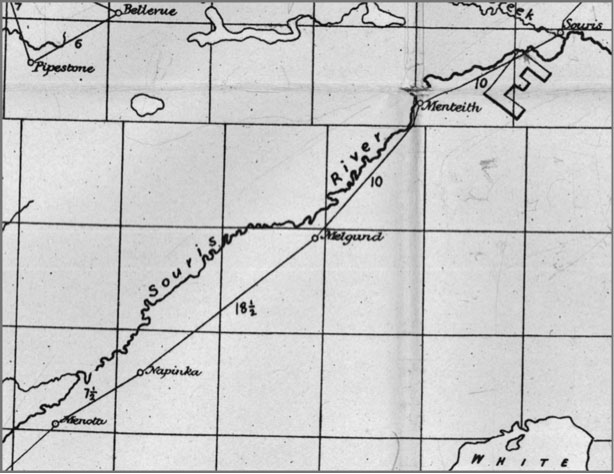 From
an 1884 map of Postal Routes
From
an 1884 map of Postal Routes
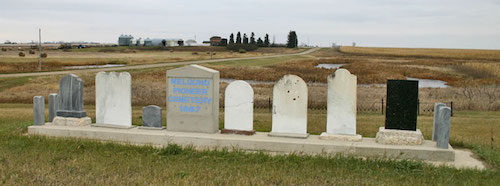 Southwest
of Hartney on Melgund Road, there is a small cemetery at a
crossroads. Established in 1887, it was the first graveyard in the
region. Across the road, a cairn helps to mark the spot that was home
to many people over many years.
Southwest
of Hartney on Melgund Road, there is a small cemetery at a
crossroads. Established in 1887, it was the first graveyard in the
region. Across the road, a cairn helps to mark the spot that was home
to many people over many years.
It
would be eight years before the railway entered the district and the
town of Hartney would be created.
The
name Melgund first appears as a Post Office opened in 1882 in the
home of W.J. Higgins. Rose School opened in, 1884, one of the first in
the area. It was also used as a church before the Melgund Methodist
Church was built across the road.
When
the first settlers arrived there were priorities. They had to
build some shelter, break some sod, and plant some grain and
vegetables. Before long they would get together and build a
school. They might build a church, and then, perhaps, a general
store or a blacksmith shop might open for business. But most such
settlements never did become towns as we know them, with rows of houses
and a main street for stores and shops.
This
small building served as the Melgund Post Office – and likely as a
residence for a time as well.
Seven
students were required for permission to open a school and in
1884 only four school age children could be found. Fortunately William
Callendar’s sister-in-law Mrs. M.E. Callendar was planning to come to
the region and locals petitioned her to come as soon as possible. It
all worked out and Rose School opened on July 11, 1884, one of the
first in the area. It was located just over a kilometre southeast of
the Post Office, and doubled as a church for about ten years before the
Melgund Methodist Church was built across the road.
The
Melgund pioneers may lay claim to being among the first settlers in
the area and Sam Long and John Fee are generally considered the
founding fathers of the Hartney District.
The
arrival of the railway to the area in 1890 prompted the creation of
commercial centres at Hartney and Lauder. The line passed just over a
kilometer north of Melgund, but proximity to Lauder and Hartney meant
that Melgund never did evolve into a village with stores and services.
It
did however continue to thrive as a community.
The
school was re-built in 1903 and was given the Melgund name as well.
It operated until 1962. A beef ring was active beginning in about
1914. A “flag station” called Emblem was established on the nearby CPR
line.
The
church continued to serve the community until 1967. A one-sheet
curling rink was established in 1947, a sure sign that the people still
preferred to support the local alternatives for recreation and
entertainment. But time marched on.
Hartney
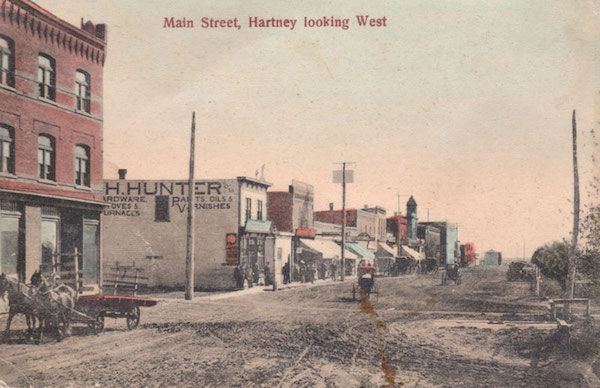
Hartney
in 1908. Municipality of Grassland Archival Collection
James
Hartney
In
1881 James Hartney, from Ontario, bought two sections of land and
hired labourers to work it before he moved to the area in 1882 with his
family. He imported a carload of Red Fife wheat from Minnesota and
after reserving enough for his own crops sold the rest to his
neighbours. By 1882 he had a good wheat crop, thus beginning the
district's reputation as a first-class wheat producing area. His
success attracted more settlers and Hartney's farm became the centre of
a new community. He was soon granted the right to open a post office,
which he named after himself. He also set up a store, first operated
out of his home and later in a separate building. He brought men into
the community to operate this business as well as a blacksmith shop
that he later established.
When
the Canadian Pacific Railway (CPR) survey was made in 1889, a
station named “Airdrie” (after a town in Scotland) was established on
the section to the north of his homestead. The community centre that
had grown around the Hartney farm shifted a half-mile to this new town
site where the road running parallel to the railway became the main
street.
Children
attended nearby Webb School until 1892, when a classroom was
opened above the newly built implement and lumber store. So for a
few years children living in town would meet the teacher, Mr.
Forrester, in town and walk to school with him.
Napinka
The
village of Napinka was created in 1891 when the CPR extended the
Souris Branch through Hartney, Lauder and on to Melita. By that
time the area had been settled for a decade and its identity as a
community was well established.
Photo
courtesy www.prairie-towns.com/
The
first house in the district was built by J. M. Grover, a Toronto
broker, in the year 1881, and was situated on the brow of a hill on the
south bank of the Souris River.
L J.
Phinney was a stone mason and built a lime kiln on the north bank
of a creek, burning limestone found on the prairie and making lime for
mortar which he used to build all the chimneys in the neighborhood and
outlying districts as well. He also plastered all the pioneer houses,
built the stone foundations for houses and barns and later in the
village, buiIt foundations for the first houses and plastered
them.
In1884,
Snyder and Warren, storekeepers who operated the Menota Post
Office, carried mail on their stage drawn by a pair of mules, from
Brandon to the most westerly settlements. All points in between where
enough settlers for a warranted it, were given a post office in a
central place on the main trail and mail was supplied once a week. J.
S. Yeoman's homestead, was Napinka’s post office and mail was sent in
bundles to outlying districts, one man coming on mail day and taking
the whole assortment or letters and papers or parcels to his
neighbours.
Mrs.
lda Crowell was the first teacher in Napinka district and this
school was the first west of Hartney and was built in 1884 a bit east
of where the town would later be located. A sod stable stood across the
road for the horses bringing the children to school or the people to
church.
This
small settlement became a busy village in the 1890’s by virtue of
its location. It was on the busy CPR Souris Branch connecting Melita to
Brandon and the branch line from Deloraine west also connected to that
line at Napinka.
Like
all railway towns, as the importance of the railway link declined,
so did the importance of the town as a commercial centre. And although
its residents may miss the grocery store, gas station and Post Office,
it is a short drive to Melita for those things. It retains its grid of
streets and houses, its community hall and its community spirit. The
school has been concerted into a Library and Drop-In Centre where
locals can gather for coffee. For quite few people, its still home
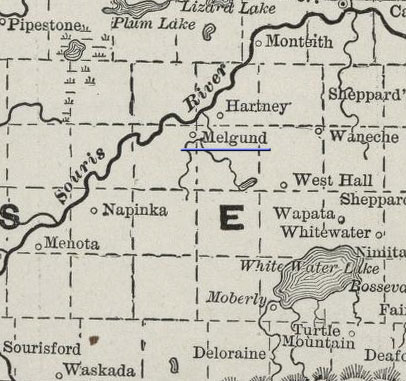 1900
1900
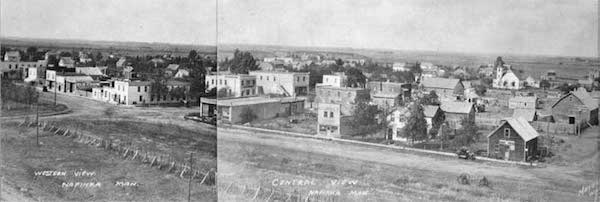
Napinka once had four churches, two hotels, and
numerous other
businesses.
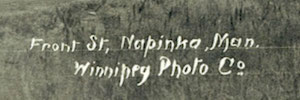
The head office of the Winnipeg Photo Co. was in Napinka!
Sources
A
Century of Living - Hartney & District 1882 - 1982, Hartney and
District Historical Committee
The
Mere Living, Hazel McDonald Parkinson, 1957
75th
Anniversary, Melgund United Church, Manitoba 1892 - 1967
|
 |
 |
|
|